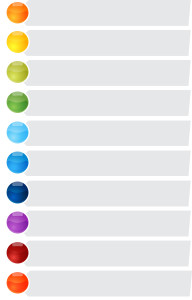Why Brains and Blogs Love Lists
 “There’s little that our brains crave more than effortlessly acquired data,” Maria Konnikova remarks ruefully in the New Yorker magazine, by way of explaining the reasons people love lists. Lists spatially organize information, helping create an easy reading experience, Konnikova explains, “in which the mental heavy lifting of conceptualization, categorization, and analysis is completed well in advance of actual consumption.” The point of using numbered lists, I explain to blog content writers, is to demonstrate ways in which your product or service is different, and to provide valuable information that engages readers, helping them see you as a go-to guy or gal to solve their problem or fill their need. There’s apparently psychological science behind the fact that the numbered list technique has been a staple for s magazine covers for as long as I can remember. I always sensed lists and bullet points in general would make a good fit for blogs, and by most accounts, search engines “like” them as well. Jay Sondemers of Forbes defines high quality content as being:
“There’s little that our brains crave more than effortlessly acquired data,” Maria Konnikova remarks ruefully in the New Yorker magazine, by way of explaining the reasons people love lists. Lists spatially organize information, helping create an easy reading experience, Konnikova explains, “in which the mental heavy lifting of conceptualization, categorization, and analysis is completed well in advance of actual consumption.” The point of using numbered lists, I explain to blog content writers, is to demonstrate ways in which your product or service is different, and to provide valuable information that engages readers, helping them see you as a go-to guy or gal to solve their problem or fill their need. There’s apparently psychological science behind the fact that the numbered list technique has been a staple for s magazine covers for as long as I can remember. I always sensed lists and bullet points in general would make a good fit for blogs, and by most accounts, search engines “like” them as well. Jay Sondemers of Forbes defines high quality content as being:
- easy to read
- suitable for scanning and skimming
As far back as 1968, neuroscientist Walter Kintsch pointed out that lists facilitate both immediate understanding and later recall. Then in 2011, psychologists Messner and Wanke concluded that we feel better when the amount of conscious work we have to do in order to process information is reduced. “Within the context of a Web page or Facebook stream,” Konnikova says, a list is the easy pick, in part because it promises a definite ending. Back in 2013, I devoted a Say It For You blog post to the topic of numbered lists, noting seven different men’s magazine covers sporting list-based titles, including “50 Great Escapes” and “6 Longest New Drivers”. Just the other day, a single news stand at my local CVS pharmacy carried four magazines with numbers-based headline teasers: (Indianapolis Diner) 13 Gourmet meals (Mountain Escapes) 62 Glorious Getaway Ideas (Entertainment ) 50 Song Movies, & TV Shows Guaranteed to Bring You Joy (Time) 240 Reasons to Celebrate America “In the current media environment, a list is perfectly designed for our brains,” concludes Konnikova. “We are drawn to it intuitively, we process it more efficiently, and we retain it with little effort.” And that’s just fine, she concludes, with the caveat that such a fast-food information diet is necessarily limited in content and nuance. Limitations notwithstanding – brains and blogs love lists!


 Biomass is what scientists use when there’s no way to do an exact count, Bill Chapell explained in an NPR radio broadcast five years ago, referring to the “fact” that The Day We Hit 7 Billion (October 31, 2011), was actually impossible to prove; it is impossible to count all the world’s people alive at any particular moment. So, he says, the experts estimate by calculating biomass.
Biomass is what scientists use when there’s no way to do an exact count, Bill Chapell explained in an NPR radio broadcast five years ago, referring to the “fact” that The Day We Hit 7 Billion (October 31, 2011), was actually impossible to prove; it is impossible to count all the world’s people alive at any particular moment. So, he says, the experts estimate by calculating biomass.  Remember the story of Goldilocks and how the little girl tried sitting in each of the Three Bears’ chairs? After rejecting the first two chairs because they were the wrong size, she tries the third: “Ahhh, this chair is just right,” she sighs. That’s exactly the sensation you want your reader to have about your blog post! But, as was the case with Goldilocks, it’s going to take some testing to achieve that result.
Remember the story of Goldilocks and how the little girl tried sitting in each of the Three Bears’ chairs? After rejecting the first two chairs because they were the wrong size, she tries the third: “Ahhh, this chair is just right,” she sighs. That’s exactly the sensation you want your reader to have about your blog post! But, as was the case with Goldilocks, it’s going to take some testing to achieve that result. “To provide an effective talk, you must slash back the range of topics you will cover to a single, connected thread,” cautions
“To provide an effective talk, you must slash back the range of topics you will cover to a single, connected thread,” cautions
Follow us online!